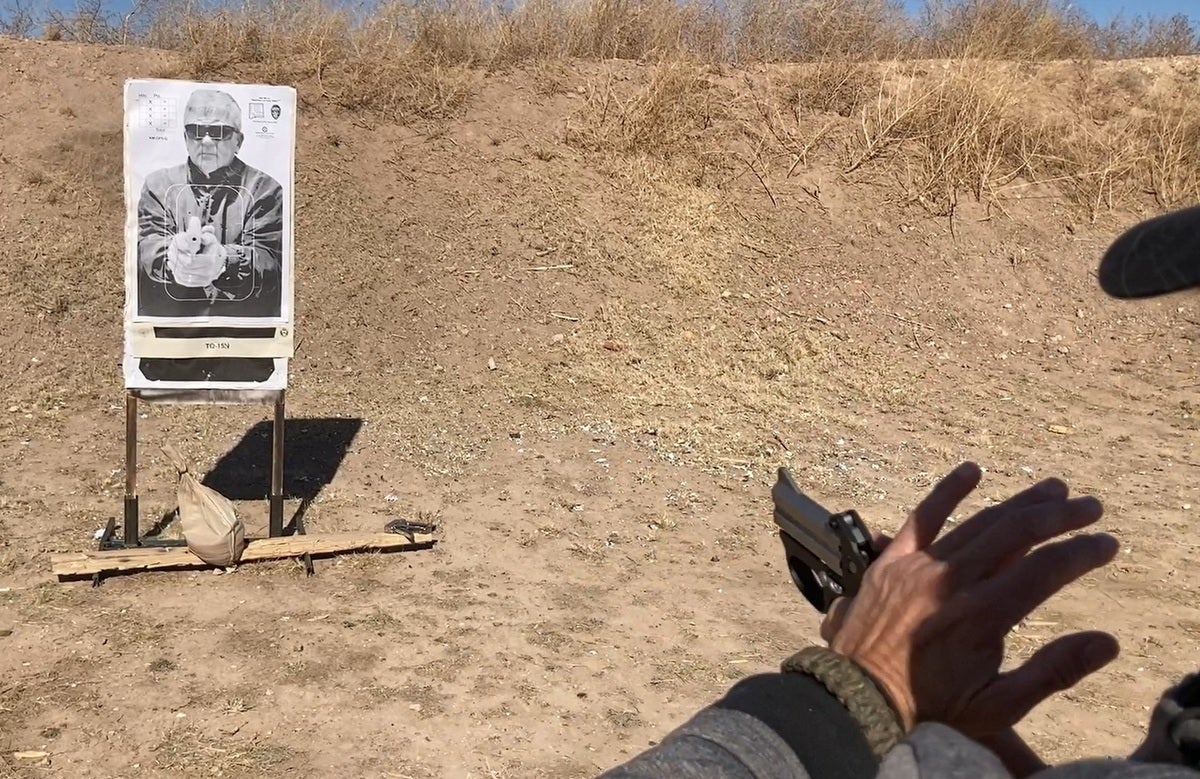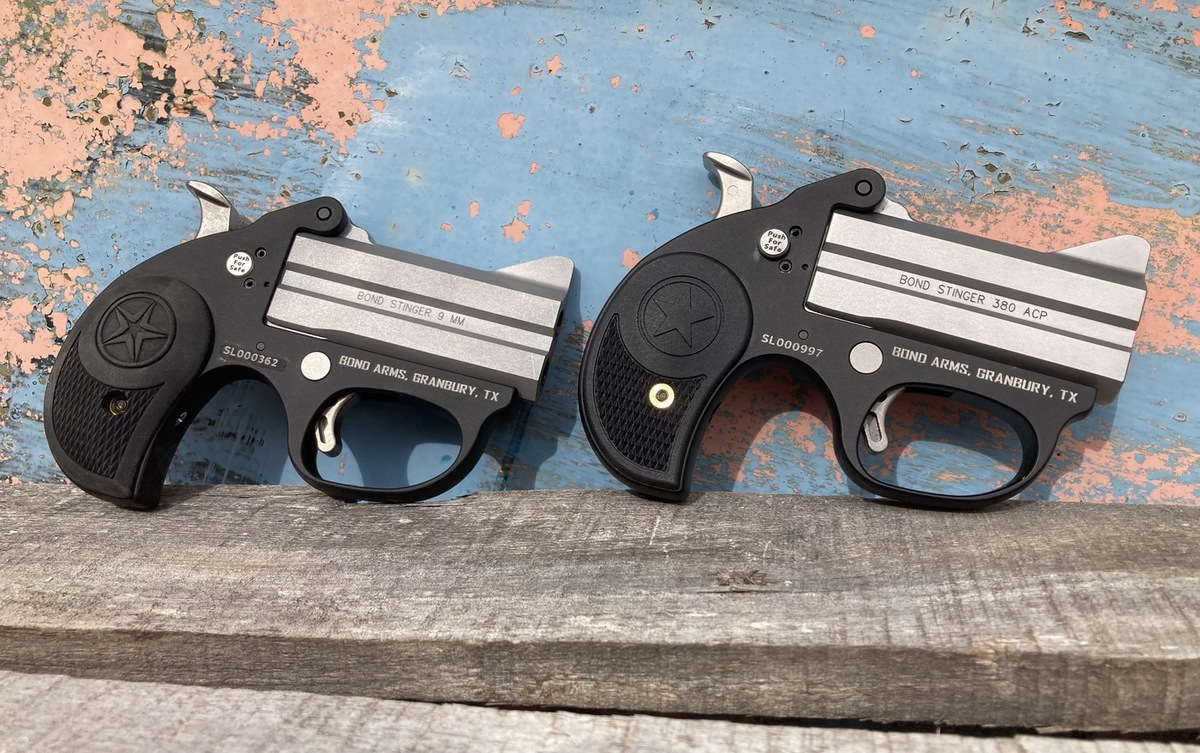AllOutdoor Review: Bond Arms Stinger – Lightens Things Up
Eve Flanigan 12.30.21

Texas-based Bond Arms, best known for their Snake Slayer derringer among many other designs, recently announced a new release called the Stinger. This latest derringer is a leaner and more concealable interpretation of the company’s iconic, Remington 95-inspired designs. I’m one of the fortunate writers who had the chance for a hands-on look at an early run of Stingers, currently offered in 9mm Luger and 380 ACP. With one of each chambering in hand, it’s been a great way to get to know what will surely be the Stinger family of guns under the Bond flag.
Most notable in comparison to other Bond Arms is the Stinger’s profile. When viewed flat, lying on a table, its footprint strongly resembles the long-standing and popular Bond Arms Backup, but the vertical profile is unlike any Bond we’ve seen yet – in a good way – at least from my vantage point. Gone are the almost voluptuous curves associated with the brand. The Stinger is slim and slab-sided, and virtually begs to be tucked into a jean pocket for easy concealment.

When I first became acquainted with the Stinger, it was at the Outdoor News America Gun Writer’s Conference in October. There, Gordon Bond and company rep Joey Hedberg showed off 9mm and 380 ACP chambered Stingers with a flat-profile rendition the brand’s black Texas Star rubberized grips, which secure though the frame with a single screw. When the writers’ samples came to my door, the factory had pre-installed the more familiar convex grip as seen on the Backup model. A note accompanying the guns said the slightly plumped grips might be more comfortable, and when shooting the 9mm, they are. The plumper grips (which are the same ones used on another Bond Arms favorite; the Backup) are presently an add-on to the Stinger package. They do represent a small compromise in concealability, but one that many people will surely decide is worth having.

I was excited to get my hands on the Stinger because of the possibilities of its use as a backup to a primary gun, both on duty and off, where it’s legal of course. Its slimmer profile makes it even more concealable than other Bond derringers. So I set out to test these guns with alternate concealment in mind.
First, came the comparative experience of shooting the 9mm versus the 380. The difference is very significant! In 9mm, this petite gun bucks like a mule. The closest comparison I have is running 357 Magnum through the polymer-frame Ruger LCR. It’s doable, but with a history of wrist injury anyway, it’s not an experience I want to have on the regular. For the one-off use in self-defense or dispatching an animal, it’d be okay. In 380, that mule is much more tractable; comparable to a full-size 9mm, but still demanding a committed grip on what little there is to hold onto. I shot through a 50-round box of ammo before I knew it with no hand/wrist fatigue.
As has been the case with other Bond guns I’ve owned and used, the top barrel fires first, delivering hits about three inches above the bullseye at seven yards and slightly right. The bottom barrel fires second, placing the hit about two inches straight south of center. How do I know that’s the case? I followed another accomplished shooter’s two-round/seven yard exercise and the holes were the same.

With consideration of using this as a backup duty gun, I thought I’d put the Stinger through the paces of my state’s 25-round backup gun qualification test for law enforcement. It’s a stiff test and most-often failed among the state’s three primary pistol qualifications. The Stinger placed hits where I wanted them, though I was very deliberate to hold a tad low on head zone shots, knowing the difference between point of aim and point of impact with the top barrel. It made the hits, but yours truly did not make all the required times. Reloading this single action shooter with speed requires some specialized training that I don’t have. The case rim is slightly exposed and accessible by a fingernail for a short arc of distance around the breech, and I managed to remember where that was rather than searching for it after a couple reloads. That sped up the process some, but not enough for six-second, three-shot drills. I learned that “fanning” the hammer spur took a lot less long, and kept the gun more secure, than trying to single-hand it while not losing a grip on the gun. For one-handed defensive use, if it were necessary, I think I’d resort to using my belt or some part of my body to cock the hammer, and advise that anyone who would carry this gun for serious defense become practiced at that while keeping trigger safety top-of-mind. Cocking the hammer on such a short-barreled gun sans the support hand is hazardous business, at least for my medium-size hand.

The Stinger has another feature that differentiates it from most other Bond Arms, and that is the prominence of the crossbolt safety mechanism. It’s clearly marked, at least if one reads English, and operates similarly to a Remington 870 that wears a left-handed safety, meaning the button is pushed from the left to right for fire; vice versa to put the safety “on.” On other Bond derringers I’ve fired, the safety is partially guarded by a ridge of molding that’s integral to the frame. On the Stinger, it stands alone, and is, in this shooter’s estimation, too easy to engage/disengage. During the qualification trial, I unintentionally had the safety on when it was time to shoot once. That happened a second time when drawing the empty Stinger from a fanny pack during mock concealment dry fire. The crossbolt safety is a virtual guarantee against an unwanted discharge from, say, dropping the gun or anything that might inadvertently invade the trigger guard. However, it needs to be stiffer in operation in order to stay where the user wants it, especially in a gun that’s so small as to invite unholstered carry. To be clear, I’m not advocating unholstered carry, but a certain segment of the population is going to do it out of ignorance or negligence. Until super-slim holsters are available for this gun, I sort of understand the temptation.

Before spending time with the Stinger, I had designs on making it work clipped into the collar of my body armor or somehow pulling off wearing it on a bead chain around my neck. Neither turned out to be doable with the gun as it is. If I have any suggestion, it’d be to integrate a strong clip into the grip so that it can be clipped to a boot top or collar, keeping the muzzle in a predictable direction. Outside of that suggestion, in terms of being an enjoyable and effective backup gun, I believe Bond has done a great job with the Stinger, and that it will make staying armed possible for a new segment of customers. Base price is $379. They’re not offered for direct order. Both the 9mm and 380 models are shipping, in limited quantities, to distributors now. On the horizon for the future is also 22 Long Rifle. Here are the specifications as provided by Bond Arms:
- Weight: 12 Oz (with Slim Grips)
- Width: Less than 1″ (with Slim Grips)
- Length: 5″
- Height: 4″
- Passive Safety: Rebounding Hammer
- Manual Safety: Crossbolt Safety & Safety Locking Device (SLD)
- Action: Over/Under, Tip-Up Barrel, Single Action
- Frame: 7075-T6 Aluminum, Type III Hard Anodize
- Trigger Guard: Integral w/Frame
- Barrel: 3″ Heat Treated Stainless Steel
- Interchangeability: Compatible with other centerfire Stinger barrels, but not with existing Bond derringers
- Grips: High Impact Nylon Slim Grips
- Hinge Screw: 7/64″ Allen Wrench
- Holsters: Dedicated holsters in development, but “Compatible with many products on the market”
